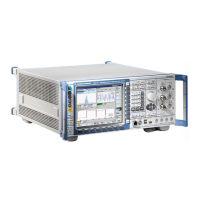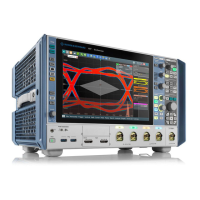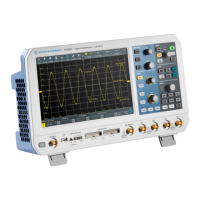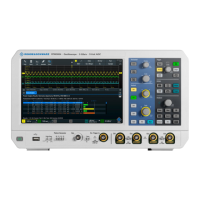CMU Special Terms and Notation
1100.4903.12 5.41 E-8
Special Terms and Notation
Below we list some particular features in the syntax of the remote control commands. The general de-
scription of the SCPI command syntax can be found in section Structure and Syntax of Device Mes-
sages on page 5.7.
Description of
commands The commands are arranged in tables; all of them are arranged in the same
way. From top to bottom, the table rows contain the following entries:
1. Complete command syntax including the parameter list and a short
description of the command,
2. List and description of the parameters with their default values, the units,
and unit rings.
3. Detailed description of the command, signalling state required for
command execution, required firmware version.
Extensive lists of default values are annexed to the command description.
Order
of commands The commands are arranged according to their function. The general purpose
of a command is described by the keyword in the second level. Lower-level
keywords define the command in more detail. This means that commands with
the same second-level, third-level etc. keywords are generally grouped to-
gether in the same sections.
Example: CONFigure:POWer
:MARKer:REFerence:POSition
<Position>
Commands with the keyword POWer in the second level belong to the power
measurement. The keywords in the third, fourth and fifth level indicate that the
command defines the position of the reference marker used in the power
measurement.
Measurement object The term measurement object denotes a group of remote control commands
relating to the same group of measured quantities. E.g., all commands con-
cerning the measurement of the signal power vs time form a common meas-
urement object.
Combined
measurements To limit the number of remote control command and their parameters, scalar
quantities of the same measurement object are always measured together and
returned in lists.
Parameters Many commands are supplemented by a parameter or a list of parameters.
Parameters either provide alternative options (setting a or setting b or setting c
..., see special character "|"), or they form a list separated by commas (setting
x,y).
<Par_Name> In the command tables and lists, parameters are generally described by a
name (literal) written in angle brackets (<>). This literal merely serves as a pa-
rameters description; in an application program it must be replaced by one of
the possible settings reported in the detailed parameter description.
Example: CONFigure:POWer:CONTrol <Mode>,<Statistics>
with <Mode> = SCALar | ARRay
<Statistics> = 1 to 10000 | NONE
possible command syntax: CONF:POW:CONT SCAL,OFF
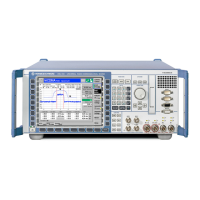
